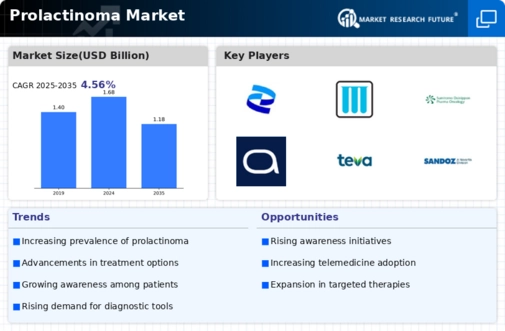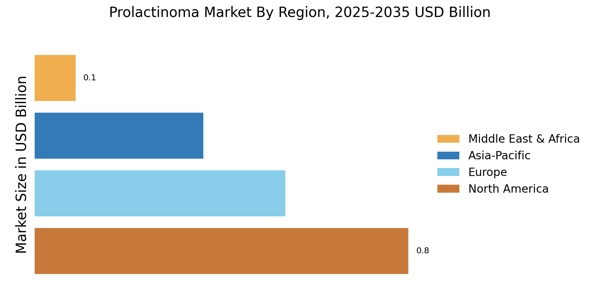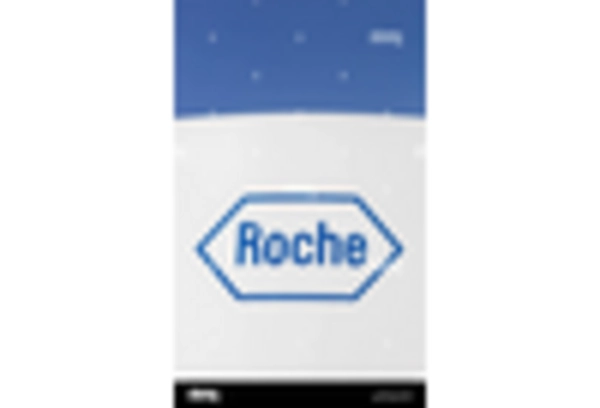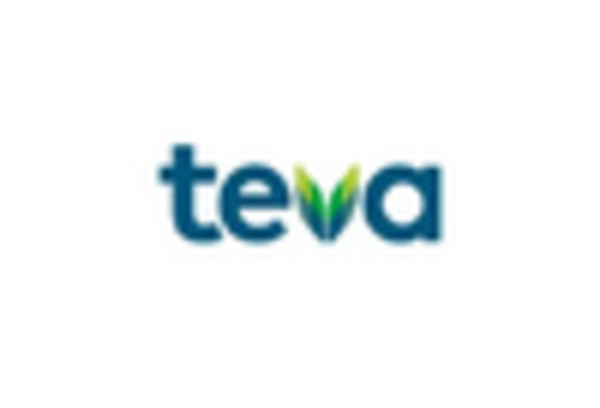Rising Healthcare Expenditure
Rising healthcare expenditure is a significant factor driving the Prolactinoma Market. As countries allocate more resources to healthcare, there is an increased focus on managing chronic conditions, including prolactinoma. This trend is evident in various regions, where healthcare budgets are expanding to accommodate advanced treatment options and technologies. Higher spending on healthcare facilitates access to specialized care, including endocrinology services, which are essential for the management of prolactinoma. Additionally, increased funding for research initiatives and public health campaigns raises awareness about the condition, leading to earlier diagnosis and treatment. Consequently, the Prolactinoma Market is likely to benefit from this upward trajectory in healthcare investment, as more patients seek effective management solutions.
Increasing Incidence of Prolactinoma
The rising incidence of prolactinoma is a pivotal driver in the Prolactinoma Market. Recent data indicates that prolactinomas account for approximately 30% of all pituitary tumors, with a notable prevalence among women aged 20 to 50. This increasing occurrence necessitates enhanced diagnostic and therapeutic measures, thereby propelling market growth. As awareness of this condition expands, more individuals seek medical attention, leading to higher diagnosis rates. Consequently, healthcare providers are prompted to invest in advanced diagnostic tools and treatment modalities, which further stimulates the Prolactinoma Market. The growing patient population is likely to drive demand for effective therapies, including dopamine agonists and surgical interventions, thereby shaping the future landscape of the market.
Growing Research and Development Activities
The surge in research and development activities within the Prolactinoma Market is a crucial driver of market expansion. Pharmaceutical companies and research institutions are increasingly focusing on developing novel therapeutic agents and treatment protocols for prolactinoma. This includes exploring new dopamine agonists and combination therapies that may offer improved efficacy and reduced side effects. The investment in clinical trials is also on the rise, with numerous studies underway to evaluate the long-term outcomes of existing treatments. As these research initiatives yield promising results, they are likely to enhance treatment options available to patients, thereby stimulating demand within the Prolactinoma Market. The continuous evolution of treatment paradigms is expected to attract further investment and interest from stakeholders.
Emerging Markets and Increased Access to Care
Emerging markets are playing an increasingly vital role in the Prolactinoma Market. As economies develop, access to healthcare services is improving, leading to higher diagnosis rates of prolactinoma. Countries with expanding healthcare infrastructure are witnessing a rise in the availability of diagnostic and treatment options for patients. This trend is particularly evident in regions where awareness campaigns are being implemented to educate the public about pituitary disorders. The growth of healthcare facilities and the introduction of health insurance schemes are also contributing to increased patient access to care. As more individuals receive timely diagnosis and treatment for prolactinoma, the Prolactinoma Market is expected to experience substantial growth, driven by the rising demand for effective management strategies.
Technological Advancements in Diagnostic Tools
Technological advancements in diagnostic tools are significantly influencing the Prolactinoma Market. Innovations such as high-resolution MRI and advanced hormonal assays have improved the accuracy of prolactinoma diagnosis. Enhanced imaging techniques allow for better visualization of pituitary tumors, facilitating timely and precise treatment decisions. The integration of artificial intelligence in diagnostic processes is also emerging, potentially streamlining patient assessment and management. As healthcare systems adopt these advanced technologies, the efficiency of diagnosing prolactinoma is expected to improve, leading to increased patient referrals and treatment initiation. This trend not only enhances patient outcomes but also contributes to the overall growth of the Prolactinoma Market, as more patients are identified and treated effectively.


















Leave a Comment